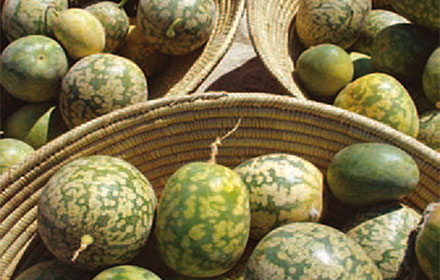Kalahari Melon (Citrullus lanatus)
en.wikipedia.org/wiki/Citrullus_lanatus
The Baobab tree grows across Africa in hot, dry lowland areas. It is common for Baobabs to live over 1000 years. It is known in Africa as ‘The Tree of Life’, because there are many traditional uses for every part of it: from the leaves to the roots. The Baobab fruit, rich in fatty seeds, is sustainably wild harvested. According to estimates by the UK’s Natural Resources Institute, 2.5 million families could receive life-changing income from the Baobab, giving people a reason to protect their trees, and to stop clearing forests, therefore helping to conserve the environment and promote biodiversity.
Properties
Baobab oil is non-siccative and contains a high percentage in beta-sitosterols that have been shown to be a strong antioxidant, and to reduce DNA damage in cells. The oil also contains vitamins A, D3 and E. Vitamin A, which, in combination with the essential fatty acids, helps rejuvenate and renew cell membranes.
Benefits
The rich yellow oil of Kalahari melon seeds has been used traditionally in Southern Africa as a moisturizer to protect the skin from the sun and to promote hair growth. It is best used for moisturizing, restructuring, and regenerating skin.
Use in NadiaZ
NadiaZ Care Line uses Kalahari Melon Oil for its incredible antioxidant and protective properties. It is found in Pequi Kiss Lip Balm, Ximenia Nectar Face Serum, and New Life Body Butter.
See also:
phytotrade.com/products/kalahari-melon-seed
oils.phytotrade.com/portfolio/kalahari-melon-seed-oil
blogs.worldwatch.org/nourishingtheplanet/tsamma-melons-watermelon
Le Melon de Kalahari est récolté à l’état sauvage et de manière durable par des coopératives de femmes. Son huile est une excellente source d’acides gras essentiels oméga-6, efficace dans l’hydratation et la restructuration de la peau. Avec près de 2 % d’insaponifiables, elle a aussi une teneur en stérols élevé, qui aident à maintenir la fonction de barrière de la peau. Son activité antioxydante élevée aide probablement la plante à survivre dans l’aride désert du Kalahari.

